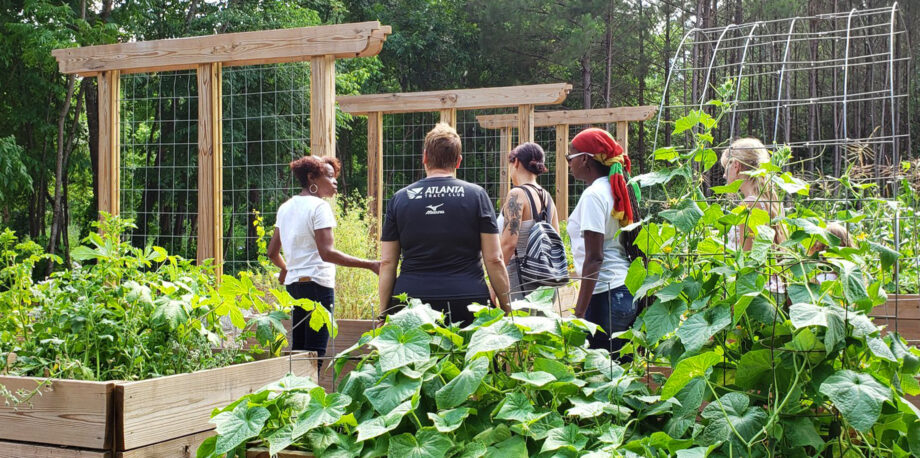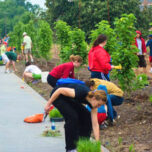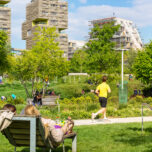August 20, 2019 — Editor’s note: The following is a contributed piece from Smart Cities Dive, a business and leadership-facing publication covering smart city trends and analysis.
Cities like Atlanta and Philadelphia are recognizing a park can be more than just a green space when visitors are allowed to pick fruits, vegetables and nuts.
A walk through an Atlanta park will soon include the option of picking berries, plucking apples from trees or gathering herbs from surrounding plants — all for free.
The Food Forest at Browns Mill, which has been years in the making, surged ahead in May when the Atlanta City Council unanimously approved an ordinance to use grant money secured from the U.S. Forest Service to purchase a 7.1-acre (2.9-hectare) plot of land from The Conservation Fund for a food forest.
The land was a working farm for decades but sold for redevelopment in 2006; the development plan was abandoned when the recession hit, and the land sat vacant until The Conservation Fund purchased it in 2016.
The park will serve as a community green space complete with trails and a large-scale edible garden. Atlanta’s Department of Parks and Recreation will oversee the property while nonprofit Trees Atlanta maintains it. Volunteers already have pitched in for site restoration and construction — including creek and pecan orchard restoration — in addition to planting hundreds of food-bearing trees and plants.
The city conducted extensive community outreach and assessments to identify available land for this project. Some of the suggested properties no longer were suitable for other developments due to issues like drainage, but they could work as a food forest. Targeting these properties carries the ancillary benefit of eliminating blight and improving quality of life for citizens within the neighborhood.
“When you transform that [property] into a lighthouse of nutrition, you have now created the greatest asset in the community out of the greatest liability,” says Mario Cambardella, urban agriculture director for the city of Atlanta.
A key component of Atlanta’s Food Forest at Browns Mill is its placement in an area the U.S. Department of Agriculture considers a food desert. The project supports a city goal of strengthening the local food economy to ensure 85% of citizens live within a half mile of access to fresh, healthy food by 2022.
In 2010, 53% of Atlanta was considered a food desert and that dropped to 36% by the end of 2017, representing approximately a quarter of the city’s population. Simply relying on grocery stores to fill the void won’t solve the food desert problem, Cambardella says.
“It’s going to take many strategies. … We have to stimulate, strengthen and support that local food system that’s going to bring affordable, equitable and resilient local food systems to these communities,” he says. “If we’re providing access to free, fresh food, that creates considerable income to be spent on other things that are just as important.”
“The kinds of partnerships food forests foster are exactly that, resilient partnerships for long-term commitments to a community.” – Rich DoleshBeyond acting as a food source for visitors, food forests can serve as a source for local food banks; a habitat for bees, birds and other wildlife; an agricultural education and enrichment tool; and a workforce and leadership skills development space.
“The notion of social resiliency is important,” says Rich Dolesh, National Recreation and Park Association (NRPA) vice president for strategic initiatives. “The kinds of partnerships food forests foster are exactly that, resilient partnerships for long-term commitments to a community.”
Cambardella says there are also lesser-known benefits. For instance, urban agriculture at Browns Mill provides resources for a local nonprofit that forages medicinal herbs to make into remedies for homeless residents’ hand, foot and extremity ailments. “It’s important to show how this one little food forest is playing a role in supporting our most vulnerable residents,” he says.
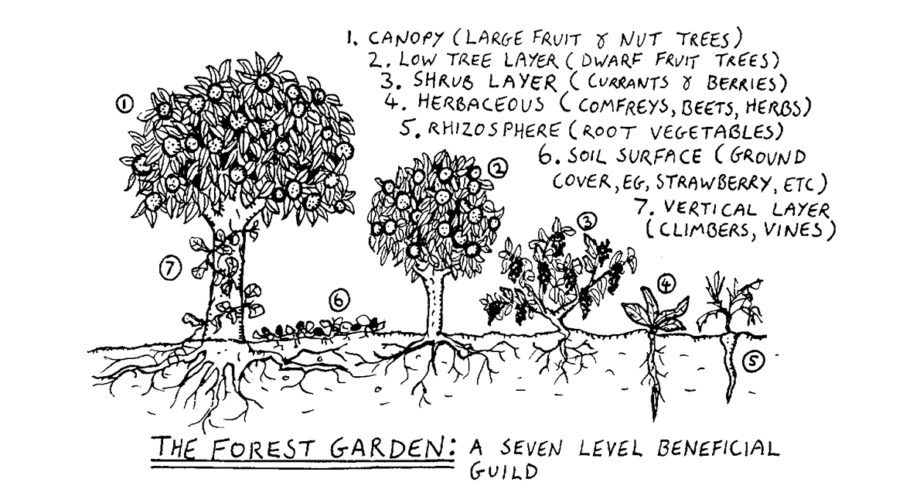
The seven layers of a complete food forest range from canopy fruit and nut trees to ground-level foods such as strawberries and roots. Image courtesy of Graham Burnett from Wikimedia Commons, licensed under CC BY-SA 3.0
Although nonprofits and community groups often drive public agriculture projects, public agencies are becoming more involved.
“Park agencies are looking for opportunities to make innovative connections to their communities. This is an emerging, innovative way to look at multi-benefit landscapes,” Dolesh says.
Taking Root Across the U.S.
Food forests are not a new concept, but up until recently, they were not widely applied in urban parts of the United States.
“The whole movement really is taking off,” Dolesh says. “A ‘food forest’ is a new name for what were traditionally called ‘community orchards.'”
Food forests are a form of permaculture, or a system of regenerating agriculture. Traditional farms, community gardens and orchards tend to grow food completely or mostly at the same plane, but food forests involve an ecological design that mimics how plants naturally grow on multiple layers within a forest.
A complete food forest has seven layers: tall fruit and nut trees serving as a canopy; shorter fruit and nut trees; shrubs or bushes that bear fruit; an herbaceous layer that includes herbs and non-woody plants such as vegetables; ground-hugging plants, such as strawberries; vines; and roots.
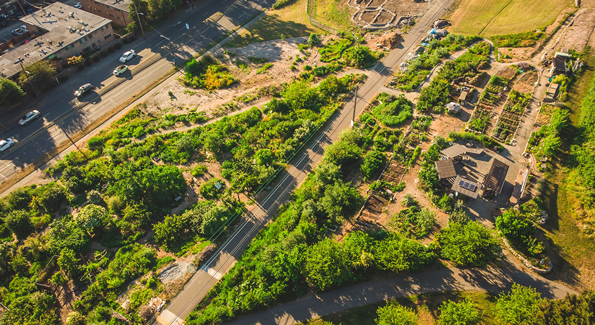
At 7 acres (3 hectares), the Beacon Food Forest in Seattle is one of the larest in the U.S. Photo courtesy of © Jonathan H. Lee via theBeacon Food Forest
While that’s the textbook answer, “the community has to answer that question of ‘what is a food forest,’ and each answers it a little differently,” Cambardella says.
One project heralded as a leader is Beacon Food Forest in Seattle, which began forming a decade ago. At 7 acres (3 hectares), it’s nearly as large as Atlanta’s food forest, which is considered one of the largest in the United States. Many communities setting up their own permaculture projects seek advice from Beacon’s organizers.
Michael Muehlbauer worked with the Beacon group and now aims to establish the Fair-Amount Food Forest in Philadelphia. His organization hopes to formalize an agreement soon with Parks and Recreation to use publicly owned parkland for the project. Like Beacon, the intention is for the Fair-Amount Food Forest to be a primarily volunteer-run project, with the hope of hiring program staff down the line.
The Fair-Amount Food Forest found collaboration in the Strawberry Mansion neighborhood and aims to increase food equity and access in an area that could be considered a food desert. Organizers have engaged community members to determine what neighborhood residents would like planted. The current plan involves more than 240 species of plants.
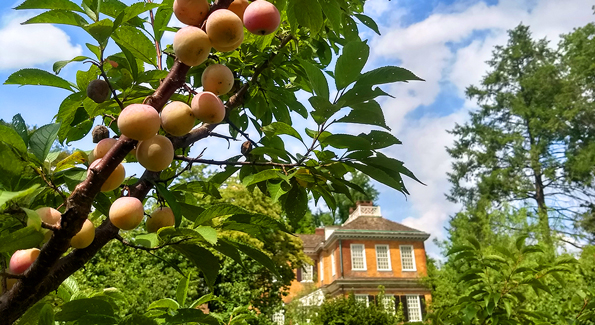
Ripe plums mark the site of the Fair-Amount Food Forest, a community-based initiative that aims to expand access to fresh fruits and other edibles for Philadelphia residents. Photo courtesy of Michael Muehlbauer/Fair-Amount Food Forest
“Our partners have been working in food access, nutrition and gardening in the neighborhood for quite a while, and this is a way for us to increase access and education [to fresh food] and food system education in the area,” Muehlbauer says.
The Philadelphia Orchard Project is another prominent urban agriculture-focused organization. It partners with other community groups to help with oversight of the more than 50 local orchard sites on city-owned land.
The organization has several principles for choosing viable partners, one of which is increasing citizens’ food security by ensuring at least some of what is grown in the orchards becomes available to those with limited access to fresh foods.
Although not all sites are open for public harvesting, “the food does have to get into the community in one way or another,” such as through food distribution or after school programs, says Phil Forsyth, Philadelphia Orchard Project executive director. The group requires that “the majority of what’s harvested gets out into the neighborhood for free.”
Not Always a Walk in the Park
Creating and maintaining a food forest bears plenty of complexities and challenges. Forging the right partnerships is key to successfully overcoming difficulties, sources say.
Many public agriculture projects in the United States are partnerships between the public sector and nonprofit groups. Often the gardens, orchards and food forests are located on publicly owned land, but nonprofit groups manage the site. Non-governmental groups tend to have more flexibility to experiment with agricultural programs and implement them quickly without encountering barriers from layers of bureaucracy.
An obvious issue is figuring out how much funding is necessary and securing a source. Federal grants exist for park permaculture, as do grants through organizations like NRPA.
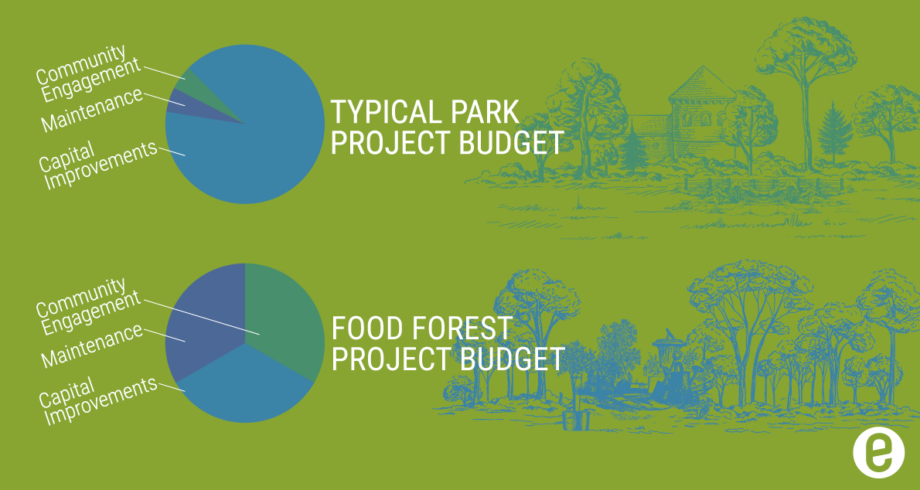 The budgeting for a food forest takes some research because it isn’t necessarily the same as other public green spaces. For example, a typical park project might budget 90% of its funds toward capital improvements, 5% for community engagement and 5% for maintenance, Cambardella says. But the Food Forest at Browns Mill is splitting its budget in thirds: 33% toward capital and infrastructure improvements, 33% toward community engagement and 33% toward the required management for a food-producing landscape.
The budgeting for a food forest takes some research because it isn’t necessarily the same as other public green spaces. For example, a typical park project might budget 90% of its funds toward capital improvements, 5% for community engagement and 5% for maintenance, Cambardella says. But the Food Forest at Browns Mill is splitting its budget in thirds: 33% toward capital and infrastructure improvements, 33% toward community engagement and 33% toward the required management for a food-producing landscape.
Choosing regionally appropriate plants must be part of the process. Apples and peaches are frequently requested items, “but those can be the two most challenging fruits to grow in a humid climate like ours,” says Philadelphia Orchard Project’s Forsyth. “We do a lot of work educating partners on other choices … that are much easier to grow, and therefore are more likely to get consistent production from year to year.”
In addition, certain plants and trees will bear fruit and nuts relatively quickly, whereas others won’t produce a yield for many years after planting.
Although permaculture in many ways is self-sustaining, ongoing care is necessary, especially in urban settings.Ongoing landscape management is sometimes overlooked but should be considered because it is both funding and labor intensive, sources say. Although permaculture in many ways is self-sustaining, ongoing care is necessary, especially in urban settings.
“It’s a very challenging proposition to manage these,” Dolesh says. “Fruit-bearing trees are problematic for parks.” If the land is not properly maintained, “food winds up on ground, it gets trampled, it starts rotting, it draws beasts,” he says.
Another critical consideration is that food-bearing plants attract pests that can lessen yield, or even decimate crops. Although traditional farms might use pesticides and fungicides to mitigate that problem, public permaculture projects rely on organic land management principles to ensure the public feels comfortable and safe harvesting and ingesting the food.
“You have to look at a whole organic regime of integrated pest management. It’s going to be a challenge to manage those and you need highly-trained staff and volunteers to do this right,” Dolesh says. Besides insects, public permaculture “is a buffet” for animals including deer, raccoons, skunks and rats.
“You have to manage the land extensively to control those and not let them completely take over a food forest intended for public benefit,” Dolesh says, adding that it takes “a balance.”
Balance also is necessary to ensure people do not overharvest at a food forest. Signage helps to remind harvesters to respect the space for the rest of the community.
Public education plays a significant role in preventing overharvesting. Citizens cannot be expected to automatically know which fruits, nuts and herbs are usable.
For example, the Atlanta community largely targeted raspberries for its food forest because that was what they knew, but few residents realized the area’s many mulberry trees bear edible fruits, Cambardella explained. Other food forest visitors don’t know how to harvest at all.
“The education on how to utilize and benefit from different plants, how they grow and the environment… needs to be part of the picture for actual change.” – Michael MuehlbauerEducating people about the variety of productive crops and driving them toward lesser-known ones can prevent overharvesting while opening doors to underutilized food sources. The combination of better healthy food access and education can prompt people to make better nutritional decisions in their daily lives.
Educational elements are at the forefront of planning for the Fair-Amount Food Forest in Philadelphia as well.
“Just providing access to food isn’t really the whole picture. The education on how to utilize and benefit from different plants, how they grow and the environment … needs to be part of the picture for actual change,” Muehlbauer says.
Regardless of the challenges, investments in public permaculture projects continue to grow due to the abundant advantages.
“Food forests really help to make resilient communities. They add value not just for the infrastructure aspects but also resiliency outcomes. The partnerships formed are deep and lasting,” Dolesh says.
Related Posts
Ensia shares solutions-focused stories free of charge through our online magazine and partner media. That means audiences around the world have ready access to stories that can — and do — help them shape a better future. If you value our work, please show your support today.
Yes, I'll support Ensia!